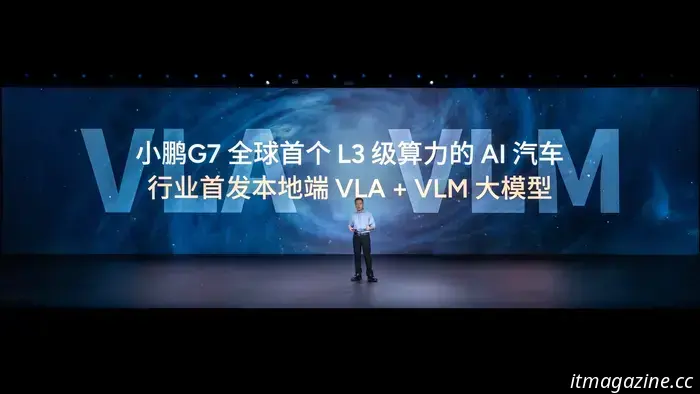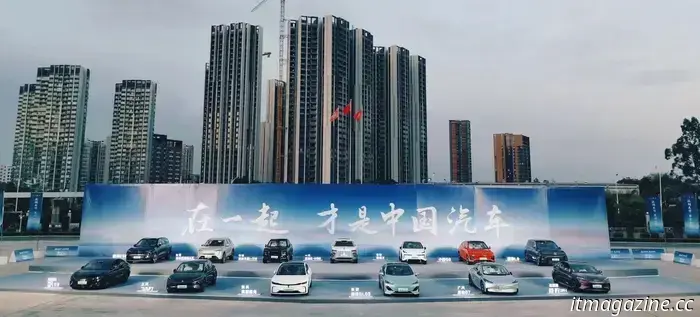
Xpeng's latest G7 SUV incorporates 2,200 TOPS in-house chips in its pursuit of Level 3 autonomous driving.
On Wednesday, June 11, 2025, He Xiaopeng, the CEO of Xpeng Motors, spoke at a press event. Credit: Xpeng Motors
On Wednesday, Xpeng Motors introduced what it claims to be the world's first AI-defined vehicle that possesses the necessary processing power for Level 3 semi-autonomous driving in everyday cars. The G7 sports utility vehicle is notable for being the first to feature Xpeng’s custom-designed Turing chip, which is equivalent to three previous Nvidia models used by the electric vehicle manufacturer, according to CEO He Xiaopeng.
Significance: The G7 is one of Xpeng’s three strategic models expected to launch this year and could significantly boost sales for the company, as management anticipates it will be the most competitive SUV in the Chinese market this year, priced at RMB 250,000 ($34,825).
The success of the G7, driven by Xpeng’s specially designed AI computer, is essential for the company's goal to be among the first automakers to release L3 autonomous vehicles later this year, pending the resolution of regulatory challenges.
Further Details: On Wednesday, Xpeng started accepting refundable deposits of RMB 2,000 for the G7, which has a pre-sale price of RMB 235,800 ($32,847). The company reported receiving over 10,000 reservations within just one hour of the vehicle's announcement.
The top-tier version of the G7 features three Xpeng Turing computer chips, which the company asserts will collectively deliver 2,200 trillion operations per second (TOPS). Xpeng claimed this capability will enable the vehicle to locally operate a large language model with over 30 billion parameters.
The base model of the G7, similar to Xpeng's existing cars, will be equipped with two Nvidia DRIVE Orin chips, which support Xpeng's current assisted driving system, XNGP. Each Orin chip provides a performance of 254 TOPS. All G7 variants will include Xpeng’s latest head-up display enhanced with Huawei’s input.
The all-electric crossover is approximately 4.9 meters long and over 1.6 meters high, offering slightly more space than the Tesla Model Y but being a bit smaller than Xiaomi’s upcoming YU7. The single-motor variant can travel 702 kilometers (436 miles) on a single charge.
The L3 conditional autonomous system allows the human driver to avoid constant monitoring of the vehicle while remaining prepared to take over, as defined by the Society of Automotive Engineers (SAE).
Context: Xpeng delivered 162,578 vehicles in the first five months of this year, nearly three times the amount delivered in the same period last year. In addition to the G7, the company plans to release a redesigned P7 sedan in the coming weeks, alongside its first extended-range hybrid model later this year.
Jill Shen is a technology reporter based in Shanghai, covering topics related to Chinese mobility, autonomous vehicles, and electric cars. You can reach her via email at [email protected] or on Twitter at @jill_shen_sh.


Other articles
 Huawei Pura 80 Ultra introduces dual-focal telephoto lens-switching technology.
On Wednesday, Huawei introduced its Pura 80 series smartphones, which includes four models: Pura 80, Pura 80 Pro, Pura 80 Pro+, and Pura 80 Ultra. As the company's flagship release of the year centered on imaging, the series showcases cutting-edge imaging technology along with the HarmonyOS 5.1 operating system.
Huawei Pura 80 Ultra introduces dual-focal telephoto lens-switching technology.
On Wednesday, Huawei introduced its Pura 80 series smartphones, which includes four models: Pura 80, Pura 80 Pro, Pura 80 Pro+, and Pura 80 Ultra. As the company's flagship release of the year centered on imaging, the series showcases cutting-edge imaging technology along with the HarmonyOS 5.1 operating system.
 realme is preparing a new "bomb" — the P-series rushes into battle
Realme has decided to "break the mold" again and announced the global launch of a new smartphone line called realme P.
realme is preparing a new "bomb" — the P-series rushes into battle
Realme has decided to "break the mold" again and announced the global launch of a new smartphone line called realme P.
 The conflict between BYD and Great Wall Motor escalates as Geely and GAC enter the fray.
BYD, which is already a prominent leader in the Chinese automotive market, has faced allegations of engaging in unfair competition through consistent price reductions and pressuring others to do the same.
The conflict between BYD and Great Wall Motor escalates as Geely and GAC enter the fray.
BYD, which is already a prominent leader in the Chinese automotive market, has faced allegations of engaging in unfair competition through consistent price reductions and pressuring others to do the same.
 Seasun Games has declared the worldwide launch of the Chinese sci-fi mecha game Mecha BREAK on July 2.
Chinese developer Seasun Games has revealed that its original near-future sci-fi mech combat title, Mecha BREAK, will be released worldwide on July 2.
Seasun Games has declared the worldwide launch of the Chinese sci-fi mecha game Mecha BREAK on July 2.
Chinese developer Seasun Games has revealed that its original near-future sci-fi mech combat title, Mecha BREAK, will be released worldwide on July 2.
Xpeng's latest G7 SUV incorporates 2,200 TOPS in-house chips in its pursuit of Level 3 autonomous driving.
The achievement of the G7 will be vital for Xpeng's goal of being one of the first automakers to introduce L3 autonomous vehicles in the latter half of this year.
